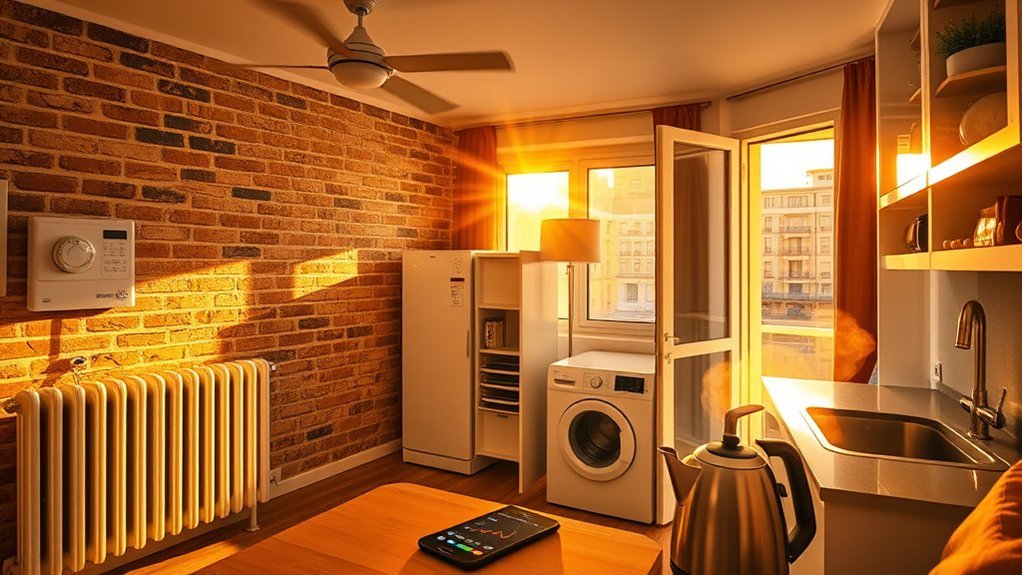You can live comfortably in Spain on roughly €1,200–€2,500 a month as a couple in most cities, and about €700–€1,200 in smaller towns or Andalusian coastal areas. Rent, utilities, groceries and transport vary widely—big cities cost more, smaller towns save you on housing and daily expenses. Public healthcare is available if you register, while private plans run €50–€100 monthly. Keep reading to compare regions, budgets, and key bills so you can plan precisely.
Housing and Residency Requirements in Spain

Although housing costs vary widely across Spain, you’ll generally find more affordable options outside major cities: furnished two-bedrooms in Barcelona or Valencia often run $1,200–$2,000+ per month, while one-bedrooms in Andalusian towns can start near $450. You’ll weigh average rental figures against property prices if you want independence: one-bedrooms in Barcelona/Valencia average about $170,000, new two-bedrooms from $250,000. For residency, a Certificate of Habitability matters — you must have it to register residency and access public healthcare. Without that certificate, you risk problems registering utilities or qualifying for services, so check documents before signing. Compare neighborhoods by living expenses and anticipated utility needs; coastal towns often have lower property prices and average rental costs than big cities. Consult local authorities and providers to confirm regulations, rates, and eligibility. That due diligence protects your freedom to move, simplifies residency steps, and keeps housing aligned with your budget and lifestyle goals.
Monthly Utilities and Household Running Costs

After you’ve picked a neighborhood and secured a place with the right paperwork, you’ll want to budget for monthly utilities and running costs, which are generally lower than in North America. Expect monthly utilities — electricity, water and garbage — to run roughly €100–€250 depending on apartment size and location. The average cost for electricity and water combined sits near €150 for a standard flat, though heating or cooling in major cities can push that higher during extremes.
When you compare rent and utilities, Spain often feels liberating: lower household running costs free up cash for experiences. Internet is part of that freedom, with affordable connectivity from €20–€40 per month. Factor these numbers into your cost of living calculations and you’ll see why many choose Spain for smarter budgeting. Keep usage habits in mind; efficient routines and moderate thermostats keep bills predictable and aligned with your goals.
Food, Dining and Grocery Prices

One couple can comfortably cover groceries for about €250–€300 a month in Spain, thanks to frequent supermarket discounts on staples and seasonal produce. You’ll find the cost of groceries low: €1.00 for a liter of milk, €1.20 for a loaf of bread, and €2.50 for a dozen eggs. That average monthly figure frees you to spend on dining out without guilt.
| Item | Typical Price | Tip |
|---|---|---|
| Menu del día | €10–€15 | Best value midday |
| Inexpensive restaurants | ~€12/meal | Cheap social dining |
| Glass of wine | ~€2 | Affordable nightlife |
Dining is comparative advantage: a mid-range three-course meal for two is about €50, so you can choose daily home cooking or occasional restaurant treats. You’ll enjoy food culture without overspending — embrace seasonal markets, hunt discounts, and balance groceries and inexpensive restaurants to maximize freedom in Spain.
Transportation and Mobility Options

You’ll find public transit in Spain is cheap and efficient — single tickets run about €1.50–€4 and monthly passes are roughly €50, with options like Barcelona’s T-10 offering ten rides for ~€11.20. In cities you’ll often save more by skipping a car and using trains, buses or promos on low-cost flights for intercity trips. Bike-sharing and other micromobility programs (e.g., Bicing €50, BiciMAD €25) make short commutes greener and even more affordable.
Public Transit Costs
While fares vary by city and distance, expect single tickets to run roughly €1.50–€4 and monthly passes to average about €50 for unlimited travel within set zones. You’ll find public transportation reliable and affordable: monthly public transportation passes free you from daily ticket buying, and public transport costs stay lower than car ownership. In Barcelona the T-10 card (≈€11.20) stretches value if you travel intermittently. Major cities pair well-developed public transportation networks with extensive bike-sharing programs — an appealing, eco-friendly mobility mix that supports autonomy.
| Option | Cost | Feeling |
|---|---|---|
| Single ticket | €1.50–€4 | Practical |
| Monthly pass | ≈€50 | Liberating |
| T-10 (Barcelona) | €11.20 | Efficient |
| Bike share | €25–€50/yr | Empowering |
Biking and Micromobility
Many big Spanish cities now make short trips easy and cheap with widespread bike lanes and low‑cost bike‑share schemes you can join for roughly €25–€50 a year. You can choose biking over owning a car and save money while gaining freedom — Barcelona’s Bicing and Madrid’s BiciMAD offer low annual fees and dense networks. With about 300 km of bike lanes in Barcelona and roughly 290 km in Madrid, cycling is safer and faster for many routes compared with crowded buses or metro transfers. Pair bike-sharing programs with monthly public transportation passes (~€50) when you need longer trips; that combo maximizes mobility and cuts costs on living in Spain. EU roaming rules keep you connected as you move between modes.
Healthcare, Insurance and Miscellaneous Expenses

If you’re a registered resident with a valid permit, you’ll get access to Spain’s highly rated public healthcare at no direct cost, while private plans run roughly €50–€100 monthly depending on coverage. Expect modest out-of-pocket fees for procedures—typically €20–€40—and prescriptions are generally inexpensive, especially with insurance. Compare public wait times and breadth of services to private speed and extras when deciding if a ~€100 expat premium (often including dental) is worth it for peace of mind.
Public Vs Private Care
Because Spain gives registered residents free public healthcare with a valid residency permit, you’ll get high-quality services and low out-of-pocket costs without paying monthly premiums. Public healthcare ranks highly and covers most needs for residents, making care accessible and affordable. Private healthcare adds speed and choice: private health insurance averages about €100 per month (roughly $50–$100 depending on plan) and shortens waits for specialists. You’ll weigh cost versus convenience—public care is strong and low-cost; private plans buy flexibility. Prescription medication remains inexpensive with insurance, and typical medical procedures only incur modest fees, so even mixed use stays affordable. Choose public-first to secure baseline care, then add private insurance selectively for faster access or specialized services.
Out-of-Pocket Costs
While public healthcare in Spain covers most needs for registered residents, you’ll still budget modest out-of-pocket amounts for co-pays, private plans, and everyday services. Public healthcare is free if you have a residency permit, but private health insurance (€50–€100/month) lowers healthcare costs and waiting stress. Out-of-pocket costs for procedures are €20–€40; prescription medication is generally inexpensive with coverage. The average waiting time for specialists is about 2–3 weeks, so you can choose speed or savings.
| Item | Typical cost | Notes |
|---|---|---|
| Private insurance | €50–€100/mo | Faster access |
| Procedure co-pay | €20–€40 | Low out-of-pocket costs |
| Personal services | €30–€100 | Haircuts, massages |
| Entertainment costs | €50–€100/mo | Variable by lifestyle |
Sample Monthly Budgets and Regional Cost Comparisons

When you compare sample monthly budgets across Spain, you’ll see clear trade-offs between major cities and smaller towns: a comfortable family budget generally runs €2,200–€2,881, but in Madrid or Barcelona you’ll pay roughly €800 for a one‑bedroom rent versus about €450 in smaller cities like Málaga. You can use that gap to reclaim freedom: choosing a smaller city lowers your cost of rent and utility costs, freeing income for travel or savings. Factor in dining — a mid-range meal for two runs about €50, inexpensive meals near €12 — and transportation costs, where a monthly pass is roughly €50. Match your monthly budget to the average salary in your region to see realistic expectations for living in Spain. Regional cost comparisons show utilities (€100–€250) and groceries shift totals more than occasional splurges. Decide which trade-offs you’ll accept, and design a budget that prioritizes mobility, experiences, and autonomy.
Frequently Asked Questions
Is It Cheaper to Live in the US or Spain?
Spain is cheaper — cost comparison shows lower living expenses, housing prices, food costs, transportation fees, and often healthcare services; you’ll gain lifestyle differences and stretch currency exchange advantages, freeing you to live more affordably and enjoyably.
Can You Live in Spain With $2000 a Month?
Yes — you can live in Spain on $2,000 a month if you embrace lifestyle changes: prioritize affordable housing options, track living expenses, use budgeting tips, enjoy local cuisine, manage healthcare costs, compare transportation fees, and seek cultural experiences.
Can a US Citizen Live in Spain?
Yes — you can live in Spain if you meet visa requirements and choose residency options like Non‑Lucrative or Digital Nomad. Consider cost of living, health insurance, employment opportunities, cultural differences, language barriers, and active expat communities.
How Much Does It Cost to Live in Spain in American Dollars?
You’ll pay roughly $1,300 monthly solo, $2,200–$3,100 for a family; cost of living favors freedom, with lower housing expenses, grocery prices, transportation costs, healthcare affordability, utility bills, and modest entertainment expenses for an expat lifestyle.
Conclusion
Moving to Spain can be surprisingly affordable: renting outside Madrid/Barcelona often costs 30–50% less. You’ll pay roughly €600–€1,200 monthly for rent in mid-sized cities, utilities €100–€150, groceries €200–€300, and public transport €40–€60. Note one fun stat: Spain has Europe’s second‑longest average life expectancy, which helps explain strong public healthcare—your taxes buy lasting value. Weigh region, lifestyle and residency rules, and you’ll pick the budget that fits.


